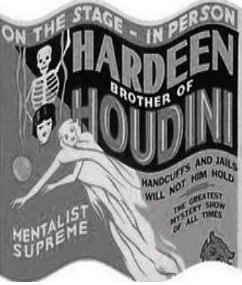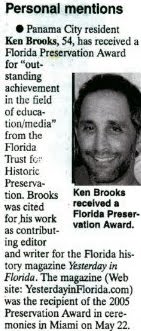Harry Houdini--born Erich Weiss to a family of Jewish Hungarian immigrants--rose from an impoverished Wisconsin childhood to international stardom during the early-1900s as a magician and escape artist nonpariel, playing to packed houses in major cities around the globe.
But the Houdini name has connections to the Florida Panhandle as well.
In the hours before he died of peritonitis in October 1926, Harry Houdini summoned wife Bess and brother Theo to his deathbed and vowed to contact them from the afterlife.
Bess would spend the rest of her life attempting to contact her late husband. On February 8, 1937, she spent a night at Panama City's Dixie-Sherman Hotel where, the local newspaper reported, she conducted an eerie ceremony in the wee hours, a seance that failed to conjur Harry's spirit. Nonetheless, the incident has since blossomed into an oft-told legend among Bay County locals.
Not so well known is the Houdini family's other connection to the area.
On Jan 29, 1938, brother Theo--billed as the Great Hardeen--performed live at Panama City's Ritz Theater on Harrison Avenue. "In Hardeen," the News Herald reported, "Houdini lives again. It is the desire of Hardeen to carry on the feats of his brother and in this manner keep alive his wonderful name."
Hardeen headlined the largest show Panama City had ever witnessed. Ads boasted a "Broadway-style review...featuring 42 people, 15 big scenes, glorious and daringly different girls!" Due to itsburlesque nature, the show didn't begin until 11pm. Tickets cost 35 cents--big money in depression days. But the Houdini connection sold tickets.
As young boys, Harry and Theo (they would change their names upon entering show business) worked as a team, performing in beer halls and dime museums around Coney Island. Here they perfected the escape tricks that would propel one of them to international renown.
After a hit performance at the 1893 Chicago World's Fair the brothers split, performing near-duplicate acts at separate venues. Theo, it was said, could replicate all his brother's tricks save one: the strait-jacket escape that would become Houdini's signature. (Harry could disclocate both his shoulders, say historians, Hardeen but one).
When Harry died, his will granted "all my theatrical effects and illusions to my brother." But Hardeen's fame and success was but a glint of Harry's. Theo, in the words of Houdini biographer Bert Sugar, "possessed none of his brother's personality and flair." Clearly, Harry's magic lay within.
The highlight of Hardeen's performance at the Ritz was an attempt at the family trademark, the escape from a strait-jacket while in full view of the audience. As usual, however, Theo reduced his brother's artistry to low comedy, intentionally bungling the escape for easy laughter.
By the early-1940s, rheumatism had destroyed Theo's ability to perform, and he died in 1945. The Northwest Florida tour would be among his last.
"To be born into near fame is a dreadful fate," Sugar wrote of Theo. Indeed, for all the escapes Theo performed as the Great Hardeen, the one escape he could never truly make was from beneath his brother's shadow.
--Ken Brooks, Panama City News Herald, Aug. 8, 2000
skip to main |
skip to sidebar


Harry (left), and Theo.

Theo and Bess visit Houdini's grave at Machpelah Cemetary in Queens, NY

The Houdini family comes to the Florida panhandle...
DATELINE: PANAMA CITY...Mrs. Houdini performs a seance, and the Great Hardeen performs. BY KEN BROOKS.


Harry (left), and Theo.

Theo and Bess visit Houdini's grave at Machpelah Cemetary in Queens, NY
